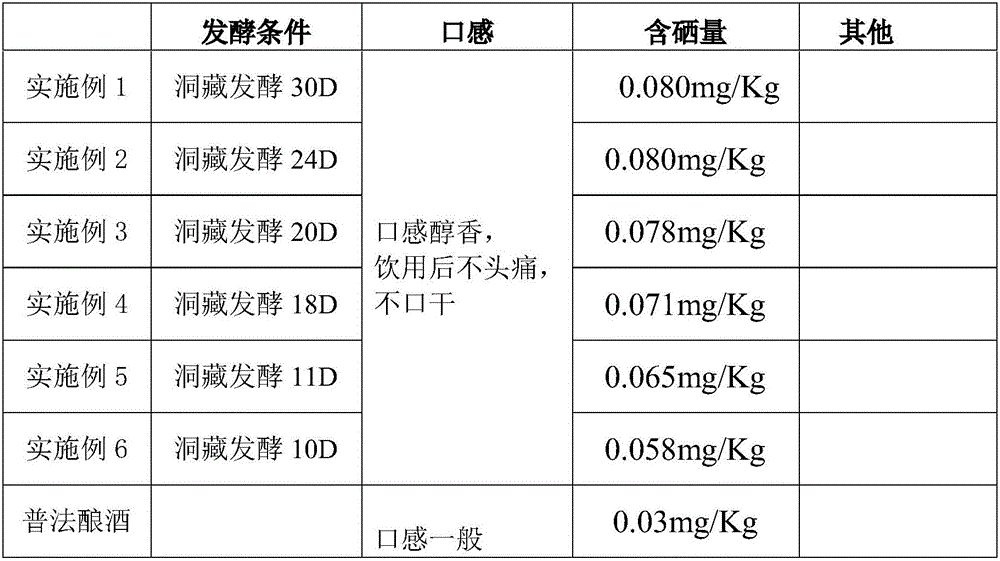Selenium-enriched rice wine and preparation method thereof
A technology of selenium-enriched rice wine and selenium-enriched rice is applied in the preparation of alcoholic beverages, pharmaceutical formulations, sulfur/selenium/tellurium active ingredients, etc. selenium and other problems, to ensure the quality and taste of wine, long aftertaste, and unique taste
- Summary
- Abstract
- Description
- Claims
- Application Information
AI Technical Summary
Problems solved by technology
Method used
Image
Examples
Embodiment 1
[0045] 1) Soaking: Soak the rice in selenium-enriched water, the water temperature is lower than 50°C, cover the surface of the rice by 3 cm, and soak for 30 minutes;
[0046] 2) Steamed rice: put the rice into the jar and spread it flat, steam the rice with steam, pour selenium-enriched water once in 6-8 minutes after the steam fully penetrates the surface of the rice, and then pour selenium-enriched water again in about 15-20 minutes, take it out and stir Evenly, break up the rice balls, and drain the bottom water at the same time, then steam the rice until cooked, and pour it with selenium-enriched water at a temperature of 50°C;
[0047] 3) Cooling: Scoop the steamed rice into the basket in time and pour it into the rice bed, blow the rice to cool, loosen the rice, pinch the rice balls, and quickly lower the temperature to 30°C;
[0048] 4), mixed koji: distiller's koji is pulverized with a pulverizer, and the temperature is controlled within 34-40°C when entering the vat; ...
Embodiment 2
[0055] 1) Soaking: Soak the rice in selenium-enriched water, the water temperature is lower than 50°C, cover the surface of the rice by 3 cm, and soak for 15 minutes;
[0056] 2) Steamed rice: put the rice into the jar and spread it flat, steam the rice with steam, pour selenium-enriched water once in 6-8 minutes after the steam fully penetrates the surface of the rice, and then pour selenium-enriched water again in about 15-20 minutes, take it out and stir Evenly, break up the rice balls, and drain the bottom water at the same time, then steam the rice until cooked, and pour it with selenium-enriched water at a temperature of 45°C;
[0057] 3) Cooling: Scoop the steamed rice into the basket in time and pour it into the rice bed, blow the rice to cool, loosen the rice, pinch the rice balls, and the temperature quickly drops to 35°C;
[0058] 4), mixed koji: distiller's koji is pulverized with a pulverizer, and the temperature is controlled within 34-40°C when entering the vat;...
Embodiment 3
[0065] 1) Soaking: Soak the rice in selenium-enriched water, the water temperature is lower than 50°C, cover the surface of the rice by 4 cm, and soak for 10 minutes;
[0066] 2) Steamed rice: put the rice into the jar and spread it flat, steam the rice with steam, pour selenium-enriched water once in 6-8 minutes after the steam fully penetrates the surface of the rice, and then pour selenium-enriched water again in about 15-20 minutes, take it out and stir Evenly, break up the rice balls, and drain the bottom water at the same time, then steam the rice until cooked, and pour it with selenium-enriched water at a temperature of 40°C;
[0067] 3) Cooling: Scoop the steamed rice into the basket in time and pour it into the rice bed, blow the rice to cool, loosen the rice, pinch the rice balls, and the temperature quickly drops to 42°C;
[0068] 4), mixed koji: distiller's koji is pulverized with a pulverizer, and the temperature is controlled within 28-34°C when entering the vat;...
PUM
| Property | Measurement | Unit |
|---|---|---|
| diameter | aaaaa | aaaaa |
| depth | aaaaa | aaaaa |
Abstract
Description
Claims
Application Information
 Login to View More
Login to View More - R&D
- Intellectual Property
- Life Sciences
- Materials
- Tech Scout
- Unparalleled Data Quality
- Higher Quality Content
- 60% Fewer Hallucinations
Browse by: Latest US Patents, China's latest patents, Technical Efficacy Thesaurus, Application Domain, Technology Topic, Popular Technical Reports.
© 2025 PatSnap. All rights reserved.Legal|Privacy policy|Modern Slavery Act Transparency Statement|Sitemap|About US| Contact US: help@patsnap.com

